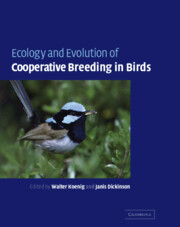Book contents
- Frontmatter
- Contents
- List of contributors
- Introduction
- 1 Evolutionary origins
- 2 Delayed dispersal
- 3 Fitness consequences of helping
- 4 Parental care, load-lightening, and costs
- 5 Mating systems and sexual conflict
- 6 Sex-ratio manipulation
- 7 Physiological ecology
- 8 Endocrinology
- 9 Incest and incest avoidance
- 10 Reproductive skew
- 11 Joint laying systems
- 12 Conservation biology
- 13 Mammals: comparisons and contrasts
- 14 Summary
- Names of bird and mammal species mentioned in the text
- References
- Taxonomic index
- Subject index
1 - Evolutionary origins
Published online by Cambridge University Press: 02 December 2009
- Frontmatter
- Contents
- List of contributors
- Introduction
- 1 Evolutionary origins
- 2 Delayed dispersal
- 3 Fitness consequences of helping
- 4 Parental care, load-lightening, and costs
- 5 Mating systems and sexual conflict
- 6 Sex-ratio manipulation
- 7 Physiological ecology
- 8 Endocrinology
- 9 Incest and incest avoidance
- 10 Reproductive skew
- 11 Joint laying systems
- 12 Conservation biology
- 13 Mammals: comparisons and contrasts
- 14 Summary
- Names of bird and mammal species mentioned in the text
- References
- Taxonomic index
- Subject index
Summary
Cooperative breeding (hereafter often abbreviated as CB) is an umbrella label that includes a diverse array of mating and social systems (Ligon 1999). For example, Brown (1987) lists 13 separate categories of CB (see also Chapter 5). The variability in the forms of CB is due to differences in both the strength and the forms of selection on helping behaviors, mating strategies, and other aspects of group living. Here we follow the commonly employed definition of avian cooperative breeding, which is that it involves the existence of social units composed of two or more breeding birds, plus one or more (often presumed) non-breeding “helpers-at-the-nest” (Brown 1987; Edwards and Naeem 1993). It is the feeding of young birds by the helpers – also referred to as alloparental behavior – that characterizes cooperative breeding and that has made it of singular interest.
For most of the history of CB studies, researchers have sought ecological factors that might have promoted the evolutionary development of CB. This search has met with limited success, in part because ecological and climatic considerations, in themselves, offer little predictive power beyond the fact that north-temperate-zone species are unlikely to be cooperative breeders (Heinsohn et al. 1990; Mumme 1992a; Cockburn 1996). Even in tropical and subtropical areas, where cooperative breeders occur most frequently, one typically cannot offer a good guess, based solely on environmental conditions, as to whether or not a given species will prove to exhibit CB.
- Type
- Chapter
- Information
- Publisher: Cambridge University PressPrint publication year: 2004
- 57
- Cited by



